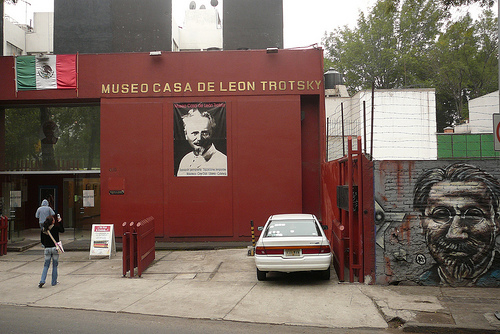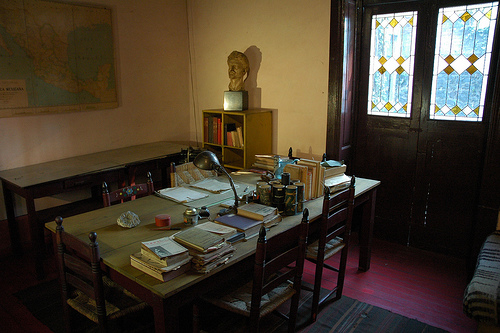

Location: Avenida Rio Churubusco 410, Coyoacán
Subway: Coyoacán
Tel. 56 58 87 32
Open: 10am- 5pm Tue- Sun

26 October (7 November) 1879- 21 August 1940
The Leon Trotsky House Museum is a public museum in Mexico City
in honor of this Russian character. The center of the complex is the
house where he lived with Natalia Sedova for fifteen months and
where he was murdered. The house was refurbished to imitate the way
it looked at that time, especially the studio in which the Soviet
NKVD agent, the Spaniard Ramón Mercader, on Stalin's orders, killed
Trotsky by hitting him on the back of the head with an ice axe. In
1990 the complex became both the museum and the headquarters of the
Institute of the Right of Asylum Leon Trotsky House Museum, A.C. The
house was declared a historical monument on September 24, 1982.
It was converted into a public museum on August 21, 1990, during
the regency of Manuel Camacho Solís in Mexico City and under the
coordination of Alejandra Moreno Toscano. Shortly after, a civil
association was formed headed by Javier Wimer Zambrano, a Mexican
diplomat and politician. This association, to which Leon Trotsky's
grandson and sole survivor, Esteban Volkov Bronstein, belongs, has
special permission from the Federal District Government to manage
the Leon Trotsky House Museum, a non-profit institution that
receives a grant from the Ministry of Culture of the Federal
District Government, which contributes to the financing of its
activities.


Trotsky was forced into exile in 1929 due to his criticism of Joseph Stalin's government. For the next eight years, Trotsky and his wife Natalia Sedova, wandered between various countries under a death sentence and persecuted by Stalinist agents. In 1937, Diego Rivera and Frida Kahlo persuaded the government of Lázaro Cárdenas to give Trotsky political asylum in Mexico.At first, the couple lived in the house of Frida Kahlo's family called "Casa Azul", which is located in the Coyoacán City Hall in Mexico City. However, in 1939, Diego Rivera and Leon Trotsky had a falling out. Some stories say that the fights were about Diego's ideology and criticism of Trotsky's writings and others claim that Trotsky had had an affair with Frida. The Trotsky couple moved to the house on Vienna Street, in the same demarcation, not far from the blue house.While Mexico had an active communist movement at that time, as elsewhere it was divided between those who supported Stalin and those who were against him. In May 1940, an assassination attempt was directed by the Mexican painter David Alfaro Siqueiros. The group was disguised as police officers and managed to overpower the guards, placed men with machine guns in the inner courtyard of the house and fired into the various rooms of the small house. Those inside survived by hiding under the bedroom furniture and only one grandson, Seva, was injured. This attack led to the construction of the walls surrounding the property and the construction of watchtowers, which gives the property the appearance of a fortress. The second and successful assassination attempt on Trotsky was made on August 20 of the same year. A Spanish supporter of Stalin named Ramon Mercader, had become the lover of Trotsky's personal secretary under the name Jacques Mornard with a Canadian passport. As such, he earned the trust of the household and was allowed to the property. That day, Mercader asked Trotsky to revise something he had written, when Trotsky was reading the writing, Mercader took an ice axe out of his coat and hit Trotsky on the back of the skull. Trotsky did not die immediately and became conscious so he was taken to the hospital for surgery. However, he died the next day. Mercader was arrested by the Mexican police, convicted of murder, for which he spent twenty years in a Mexican prison. When he was released in 1960, Mercader reportedly fled to Prague and then Moscow, where he was awarded the Order of Lenin and decorated as a Hero of the Soviet Union. According to some later reports, he finally died of cancer in Havana in 1978. The room in which Trotsky was murdered remains exactly as it was at that time, including the papers and books in their exact positions.
The museum consists of the house in which Trotsky lived, the garden
area and the exterior walls with guard facilities, which is located in a
quiet residential area next to a stream that ran next to the Churubusco
River. The newspaper La Jornada called the atmosphere of the place
"real, tense, not with abundance and not always happy." The complex was
declared a historical monument in 1982. The house is small and common
for a house built at the beginning of the twentieth century. One notable
exception is a tower topped by a bronze eagle of the type Venustiano
Carranza used during the Mexican Revolution. It is claimed that it was a
gift from Carranza to the former owner of the house, a Mr. Turatti.
Bullet holes from the attack carried out by the group led by Siqueiros
are still in the exterior walls. The interior of the house has been
kept as it was when Trotsky lived there, and it looks a bit dark and
gloomy due to the bars and steel blinds on the windows. The kitchen has
its pots and pans, the shoes are lined up next to the beds, the floors
and beds are covered by tattered Mexican fabrics. There are also some
bullet holes inside. The center of the house is Trotsky's studio where
everything, glasses, documents, books and other objects were left
exactly as they were when Trotsky was attacked.
Along the high
exterior walls and watchtowers are guardhouses and other facilities that
have been converted into exhibition halls and other museum-related
facilities. These rooms display photographs, newspapers plus Trotsky's
personal effects. As a museum, some other buildings were added along
the walls containing the photos of Trotsky's life, biographical notes in
Trotsky's Spanish. The Guards' house contains a permanent photographic
collection with images of Trotsky's family, his participation in the
Bolshevik Revolution and his family tree. In what used to be the guest
rooms at the end of the garden, dozens of black and white photographs of
Trotsky and Natalia accompanied by famous friends, such as Diego Rivera
and Frida Kahlo, were placed. There are also temporary exhibition
halls, which has new screenings of various artists every month. The
artistic exhibitions include an annual exhibition of works by graffiti
artists or "graffiteros”. The annual event aims to recognize the talent
of these "graffiti artists", who the museum considers to be victims of
marginalization. However, the event has been attended by officials from
the city's Public Security agency, technical schools and even the Cuban
embassy. In 2009, the graffiti exhibition was sponsored by the
secretary of public security of the city and a food company with about
twenty works that are considered the most representative of a contest
called "Cool things, roll them". The auditorium has eighty seats and
the Rafael Galván library has a collection of more than 6,000 volumes
mainly in the social sciences, economics and politics. The rest of the
space of the complex belongs to the garden area, which is still
maintained with tropical flowers and other plants, such as the cactus,
which Trotsky collected. There are photos in the museum of the
collection of Trotsky's cacti collected in the Mexican fields and taking
care of the garden, along with the rabbits and the chickens that were in
the hutch and chicken coops that still exist. The center of the garden
contains a stone stele designed by Juan O'Gorman, which contains
Trotsky's ashes, along with those of his wife. Above the stele there is
a mast with the Soviet flag. The museum was created on August 20, 1990,
to commemorate the 50th anniversary of the murder together with the
Institute of Asylum Law and Public Freedoms. The latter was created to
help other political dissidents seeking asylum in Mexico, but was
consolidated with the museum in 1996. The official name of the
organization is now the Institute of the Right of Asylum Leon Trotsky
House Museum. The museum receives an average of 17,000 foreign visitors
each year, along with 50,000 students from the visits organized by the
Ministry of Public Education. This generates about 20,000 Mexican pesos
in income every week. The museum is supported only by income and
donations. There is occasional support by the city government, such as
the renovation of the guard tower. Between January and March 2010, the
museum received 11,000 visitors, mostly students and foreigners, despite
the lack of a coordinated promotional effort.